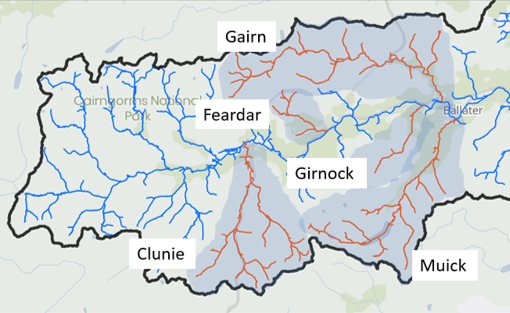
The following is a March 2024 programme update for Save the Spring, a partnership between the River Dee and Atlantic Salmon Trust, supported by the University of Stirling and University of Highlands & Islands, Inverness.
Recruitment for Programme Lead
The programme partners have begun recruiting for a River Restoration Coordinator to lead the Save the Spring work forward. While the partnership is already moving ahead with urgency and focus, in terms of both the habitat restoration and wild fish repopulation actions, this role will enable us to further accelerate and enhance the programme going forward with a view to achieving maximum positive impact for the catchment’s wild Atlantic salmon. The role is a permanent, full-time position and details including the job description can be found on the River Dee website here.
Prioritisation
The programme partners have identified 5 priority tributaries for the first phase of the programme and, this year, as we pilot the work process, work on the Muick in particular will be progressed. The Muick has been identified as a key initial focus area, based on its critically low salmon population status, its good geographic catchment access and existing working partnerships in place, an absence of impassable barriers, and improving habitat quality and water quality due to restoration work and recovery from historic acid rain impact. The other tributaries we are seeking to prioritise at this stage are the Clunie, Feardar, Gairn and Girnock. Through additional data collection carried out this year by the River Dee team (smolt trapping and electrofishing), we expect to identify which two of these tributaries can constitute key focus areas for work next year.

Habitat Restoration
The programme partners are now in the process of developing the overarching habitat restoration strategy to ensure that the work is targeted at the locations that are most important and where we can make the biggest positive difference. Part of the reason for the Muick being chosen as the initial focus area is that habitat restoration efforts have already been taking place here, including instream habitat creation (Large Woody Structures), flow management (debris and leaky dams, wader scrapes), flood channel reconnections, and tree planting. Further restoration work is already planned for 2024/25 to increase spawning habitat availability and improvement of habitat for juvenile fish.
Wild Fish Repopulation
The two proposed methods of wild fish repopulation, kelt reconditioning and release (KR) and smolt to adult supplementation and release (S2A), are now being developed. The programme partners are in discussion with both Marine Directorate (MD) and NatureScot to develop a detailed plan for both methods to ensure best practice and invite feedback. This is an important part of the process linked to the Habitat Regulations Assessment (a necessary assessment owing to the SAC status of the River Dee).
The wild fish repopulation work is being carried out in partnership with the University of Stirling’s Institute of Aquaculture. An initial capture of kelts from the upper main stem of the River Dee has recently been carried out with the support and assistance of River Dee ghillies, and the University of Stirling is currently holding these fish in their facilities. 9 female kelts were collected in February and March 2024, all of which are in healthy condition and are now beginning to feed – an encouraging sign. If any further kelts are captured in the next week or so these can also be taken in by the University of Stirling team. These fish will be reconditioned until they are ready to spawn again, at which point they will be returned to the Dee at the same locations of their capture, to spawn naturally.
The initial plan for S2A work this year is to collect a small pilot sample of 100 smolts from the River Muick priority area and transport them to the University’s land-based, closed containment marine facility on the West Coast. The smolts will be raised there (it is anticipated for around 2.5 years) until they are mature adults ready to spawn. The River Dee team has now installed two smolt traps in the River Muick and these are currently in operation – it is rather early yet but we would expect to be able to collect smolts in mid-late April.
All Muick smolts captured will be genetically sampled and this will allow us to understand the genetic structure of this subpopulation in order to maximise restoration efforts. This will provide a baseline to monitor their future spawning success, and the survival of their offspring. The genetic monitoring is being developed with the Institute of Biodiversity and Freshwater Conservation, UHI Inverness, and it is anticipated that a monitoring plan will continue until 2031.
This year smolt traps will also be running on the Feardar burn and Culter burn so that we can estimate the size of their wild smolt runs. This information will be important to feed into the developing restoration strategy, with the Culter burn in the lower Dee catchment potentially offering an appropriate comparison to the upper Dee restoration areas, being similar in terms of its requirements for restoration and with a critically low wild Atlantic salmon population, albeit one that is not predominated by spring-running fish.
Funding
We were pleased to have recently announced that a major funder for this work is bp. This funding developed following bp staff volunteering with the River Dee Trust to undertake restoration works within the catchment. The programme partners are delighted to have their support, including for the recruitment of the programme lead role, which will allow us to accelerate and enhance the initiative going forward.